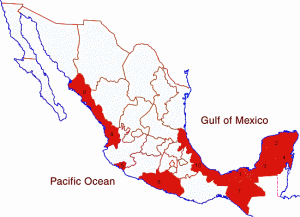The table shows the ten warmest states in Mexico, defined by their average annual temperature.
| Rank | State | Average annual temperature (degrees C) |
|---|---|---|
| 1 | Tabasco | 26.4 |
| 2 | Yucatán | 25.9 |
| 3= | Campeche | 25.8 |
| 3= | Quintana Roo | 25.8 |
| 5 | Colima | 25.3 |
| 6 | Guerrero | 24.9 |
| 7= | Chiapas | 24.1 |
| 7= | Nayarit | 24.1 |
| 9 | Sinaloa | 24.0 |
| 10 | Veracruz | 23.7 |
In both Canada and the USA, average temperatures tend to depend largely on latitude, ie. they increase towards the south of the country. This is clearly only partially the case in Mexico.
(a) What factors apart from latitude influence the average temperatures in Mexico’s states? Try to find evidence that either supports (or refutes) your ideas.
(b) Is there any connection between average temperature and precipitation amounts? Compare this map of states which are relatively warm with the states which have
(c) If you do not already know, can you guess where the coolest states in Mexico will be? Check here to find out if you are right!
Mexico’s diverse climates are the subject of chapter 4 of Geo-Mexico: the geography and dynamics of modern Mexico. Climate-related hazards are analyzed in chapters 6 and 7. Buy your copy today!

Sorry, the comment form is closed at this time.